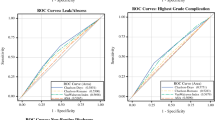Abstract
PURPOSE: Historically, complication rates after colorectal surgery have been stratified by disease process, type of operation, or anesthesia risk derived after an intensive review of the medical record. Newer computer applications purport to shorten this process and predict the probability of postoperative complications by distinguishing them from comorbidities that are commingled on uniform discharge codes. We analyzed CaduCIS™ software, which uses discharge codes, to determine whether its predictions of comorbidity and complications were comparable to what was interpreted on the medical record. METHODS: Two-hundred seventy patients were analyzed according to the principal and secondary diagnoses coded on discharge. Coding inaccuracies of clinical occurrences were identified by physician review of each medical record. The actual incidences of 17 common preoperative comorbidities and 11 postoperative complications were compared with those predicted by CaduCIS™. RESULTS: The CaduCIS™-predicted distribution of comorbidities was similar to the actual occurrences in 15 of 17 categories. The overall incidence of complications obtained by physician (actual) review was 47 percent, compared with 46 percent predicted by CaduCIS™. However, there was a statistical difference between the CaduCIS™-predicted and the actual complication rates in 5 of the 11 categories. The most common preoperative comorbidity and complication was cardiopulmonary (47 percent and 28 percent, respectively). CONCLUSION: The overall complication rate interpreted from the medical record (47 percent) was accurately predicted by CaduCIS™ (46 percent). Predictions of 5 of 11 individual complications were underestimated because of charting and coding inaccuracies, not because of computerized errors. Because uniform discharge coding of commingled comorbidity and complications is increasingly used to rapidly compute surgical outcomes, colon and rectal surgeons need to ensure compatibility of the actual and coded medical records.
Similar content being viewed by others
References
International classification of diseases, ninth revision, clinical modification (ICD-9-CM). Fourth edition. Reno, Nevada: Channel Publishing, 1998.
Brailer DJ, Kroch E, Pauly MV, Huang J. Comorbidity-adjusted complication risk: a new outcome quality measure. Med Care 1996;34:490–505.
Pennsylvania Health Care Cost Containment Council. A hospital performance report—southeastern Pennsylvania. Available at: http://www.phc4.org/hpr98/reports/hrp98/hpr/tables/south/rg3frame.htm.
Rosen L, Stasik JJ Jr, Reed JF III, Olenwine JA, Aronoff JS, Sherman D. Variations in colon and rectal surgical mortality: comparison of specialties with a statelegislated database. Dis Colon Rectum 1996;39:129–35.
Ghali WA, Hall RE, Ash AS, Rosen AK, Moskowitz MA. Evaluation of complication rates after coronary artery bypass graft surgery using administrative data. Methods Inf Med 1998;37:192–200.
Iezzoni LI, Ash AS, Shwartz M, Landon BE, Mackiernan YD. Predicting in-hospital deaths from coronary artery bypass graft surgery: do different severity measures give different predictions? Med Care 1998;36:28–39.
Romano PS, Roos LL, Luft HS, Jollis JG, Doliszny K. A comparison of administrative versus clinical data: coronary artery bypass surgery as an example. Ischemic Heart Disease Patient Outcomes Research Team. J Clin Epidemiol 1994;47:249–60.
Jollis JG, Ancukiewicz M, DeLong ER, Pryor DB, Muhlbaier LH, Mark DB. Discordance of databases designed for claims payment versus clinical information systems: implications for outcomes research. Ann Intern Med 1993;119:844–50.
Iezzoni LI, Daley J, Heeren T,et al. Using administrative data to screen hospitals for high complication risks. Inquiry 1994;31:40–55.
Green J, Winfeld N. How accurate are hospital discharge data for evaluating effectiveness of care? Med Care 1993;31:719–31.
Kohn L, Corrigan J, Donaldson M, eds. To err is human: building a safer health system. Washington, D.C.: National Academy Press, Institute of Medicine, Committee on Quality of Health Care in America, 2000.
Author information
Authors and Affiliations
About this article
Cite this article
Azimuddin, K., Rosen, L. & Reed, J.F. Computerized assessment of complications after colorectal surgery. Dis Colon Rectum 44, 500–505 (2001). https://doi.org/10.1007/BF02234321
Issue Date:
DOI: https://doi.org/10.1007/BF02234321




